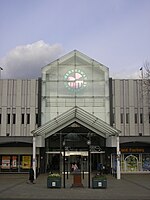Nelstrops Albion Flour Mills
Buildings and structures in StockportFlour mills in the United Kingdom

Nelstrops Albion Flour Mills, also known as Nelstrop Albion Corn Mill, Nelstrop's Flour Mill or Albion Mills, is a corn mill in Heaton Norris, Stockport, England. It is at the top of Lancashire Hill, on the roundabout next to the Navigation Inn. Nelstrops, the company which operates the mills, is one of the leading producers of flour in the United Kingdom.
Excerpt from the Wikipedia article Nelstrops Albion Flour Mills (License: CC BY-SA 3.0, Authors, Images).Nelstrops Albion Flour Mills
Belmont Way,
Geographical coordinates (GPS) Address Nearby Places Show on map
Geographical coordinates (GPS)
| Latitude | Longitude |
|---|---|
| N 53.418333333333 ° | E -2.1619444444444 ° |
Address
Belmont Way
Belmont Way
SK4 1BL , Heaton Norris
England, United Kingdom
Open on Google Maps









